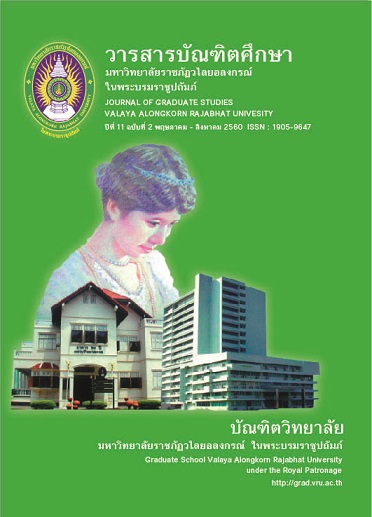การพัฒนาทักษะชีวิตของนักเรียนชั้นประถมศึกษาปีที่ 4-6โดยใช้การวิจัยปฏิบัติการแบบมีส่วนร่วม
Main Article Content
Abstract
บทคัดย่อ
การวิจัยครั้งนี้มีวัตถุประสงค์เพื่อ 1) ศึกษาสภาพ ปัญหาและความต้องการจำเป็นในการพัฒนาทักษะชีวิตของนักเรียน 2) สร้างรูปแบบการพัฒนาทักษะชีวิตของนักเรียน และ 3) ศึกษาผลการใช้รูปแบบการพัฒนาทักษะชีวิตของนักเรียนในประเด็นต่อไปนี้ 3.1) เปรียบเทียบทักษะชีวิตของนักเรียนทั้ง 4 องค์ประกอบ ก่อนและหลังการพัฒนา 3.2) เปรียบเทียบทักษะชีวิตของนักเรียนในด้านองค์ประกอบที่ 2 การคิดวิเคราะห์ ตัดสินใจและแก้ปัญหาอย่างสร้างสรรค์ก่อนและหลังการพัฒนา กลุ่มเป้าหมาย ได้มาโดยวิธีการเลือกแบบเจาะจง ได้แก่ ผู้บริหาร ครู นักเรียน ผู้ปกครอง คณะกรรมการสถานศึกษาขั้นพื้นฐานและผู้นำชุมชน โรงเรียนบ้านหนองบง สำนักงานเขตพื้นที่การศึกษาประถมศึกษามุกดาหาร ซึ่งการดำเนินการวิจัยมี 5 ขั้นตอน ได้แก่ 1) ขั้นเตรียมการ 2) ขั้นศึกษาปัญหาและกำหนดวิธีการแก้ไข 3) ขั้นวางแผนปฏิบัติการแก้ปัญหา ติดตามและประเมินผล 4) ขั้นปฏิบัติตามแผนที่วางไว้ และ 5) ขั้นประเมินผลการปฏิบัติการแก้ปัญหา เครื่องมือที่ใช้ในการเก็บรวบรวมข้อมูล คือ 1) แบบบันทึกการประชุม 2) แบบสัมภาษณ์ 3) แบบสอบถามและ 4) แบบสังเกตพฤติกรรมของนักเรียน ระยะเวลาในการศึกษา ปีการศึกษา 2558 สถิติที่ใช้ในการวิเคราะห์ข้อมูล ได้แก่ ค่าความถี่ ค่าเฉลี่ย ค่าส่วนเบี่ยงเบนมาตรฐานและค่าร้อยละ ผลการวิจัย พบว่า
1) สภาพ ปัญหาจากการศึกษาเอกสาร การประชุมและการสัมภาษณ์ ของผู้มีส่วนเกี่ยวข้องในการวิจัย มีความเห็นสอดคล้องกันว่าทักษะชีวิตของนักเรียนในด้านองค์ประกอบที่ 2 การคิดวิเคราะห์ ตัดสินใจและแก้ปัญหาอย่างสร้างสรรค์อยู่ในเกณฑ์ไม่น่าพอใจ ทำให้นักเรียนมีปัญหา และสับสนในการคิดและตัดสินใจที่จะเลือกแสดงพฤติกรรมที่เผชิญในชีวิตประจำวันให้เป็นไปอย่างสร้างสรรค์ เห็นควรส่งเสริมให้นักเรียนได้รับการพัฒนาโดยการปฏิบัติกิจกรรมตามรูปแบบการพัฒนาทักษะชีวิตที่เน้นการเรียนเรียนรู้แบบมีส่วนร่วม ตามลำดับขั้นตอนและกระบวนการในรูปแบบ ซึ่งมีความสอดคล้องกับ ข้อมูลด้านความต้องการจำเป็นในการพัฒนาทักษะชีวิตของนักเรียนจากการตอบแบบสอบถามของผู้มีส่วนเกี่ยวข้องทั้งหมด ที่เห็นว่าความต้องการจำเป็นที่ต้องพัฒนาทักษะชีวิตของนักเรียนอย่างเร่งด่วน คือ องค์ประกอบที่ 2 ด้านการคิดวิเคราะห์ ตัดสินใจ และแก้ปัญหาอย่างสร้างสรรค์ เรียงลำดับตัวชี้วัด ได้ดังนี้ 1.1) รู้จักวิพากษ์วิจารณ์บนพื้นฐานของข้อมูลสารสนเทศที่ถูกต้อง 1.2) มีจินตนาการและมีความสามารถ ในการคิดเชื่อมโยง และ 1.3) รู้จักวิธีการและขั้นตอนการตัดสินใจและแก้ไขปัญหาที่ถูกต้อง
2) รูปแบบการพัฒนาทักษะชีวิตของนักเรียนที่สร้างขึ้น มีองค์ประกอบ ดังนี้ 2.1) ชื่อรูปแบบ 2.2) ความเป็นมาและความสำคัญ 2.3) แนวคิดทฤษฎีพื้นฐาน 2.4) หลักการ 2.5) วัตถุประสงค์ของรูปแบบ 2.6) เนื้อหา 2.7) กระบวนการ 2.8) สื่อและแหล่งเรียนรู้ และ 2.9) การวัดและประเมินผล
3) ผลการใช้รูปแบบการพัฒนาทักษะชีวิตของนักเรียน พบว่า
3.1 ก่อนการใช้รูปแบบการพัฒนาทักษะชีวิต นักเรียนที่เข้าร่วมกิจกรรม มีทักษะชีวิตโดยรวมทั้ง 4 องค์ประกอบ อยู่ในระดับน้อย มีค่าเฉลี่ย เท่ากับ 2.39 คิดเป็นร้อยละ 47.80 หลังการพัฒนา มีทักษะชีวิตโดยรวมทั้ง 4 องค์ประกอบ อยู่ในระดับมาก มีค่าเฉลี่ย เท่ากับ 4.28 คิดเป็นร้อยละ 85.60 เพิ่มขึ้น ร้อยละ 37.80 ของคะแนนเต็ม
3.2 ก่อนการใช้รูปแบบการพัฒนาทักษะชีวิตของนักเรียน ในด้านองค์ประกอบที่ 2 การคิดวิเคราะห์ ตัดสินใจ และแก้ปัญหาอย่างสร้างสรรค์ มีทักษะชีวิตอยู่ในระดับน้อย มีค่าเฉลี่ย เท่ากับ 1.68 คิดเป็นร้อยละ 33.60 หลังการพัฒนามีทักษะชีวิตอยู่ในระดับมาก มีค่าเฉลี่ย เท่ากับ 4.45 คิดเป็นร้อยละ 89.00 เพิ่มขึ้น ร้อยละ 55.40 ของคะแนนเต็ม
นอกจากนี้ผลการวิเคราะห์ข้อมูลเชิงคุณภาพจากการสังเกตพฤติกรรมและแบบบันทึกการถอดบทเรียนของนักเรียนที่เข้ารับการพัฒนา แสดงให้เห็นว่า การเรียนตามรูปแบบการพัฒนาทักษะชีวิตที่พัฒนาขึ้น ช่วยส่งเสริมให้นักเรียนมีทักษะชีวิตใน การคิดวิเคราะห์ ตัดสินใจ และแก้ปัญหาอย่างสร้างสรรค์ ได้ดีขึ้น พร้อมทั้งส่งผลให้ทักษะชีวิตของนักเรียนกลุ่มเป้าหมายทั้งหมด 4 องค์ประกอบ มีพัฒนาการสูงขึ้นตาม และยังช่วยพัฒนาทักษะการทำงานร่วมกับผู้อื่น
ABSTRACT
The purposes of this study were: 1) to study the state, problem, and needs assessment for life skills development 2) to construct the life skills development 3) to investigate the effects of using the life skills development model, namely 3.1) to compare four components of the students life skills between pre- development and post- development, and 3.2) to compare the students life skills of the second component : critical thinking, decision making and creative problem solving between pre- development and post- development. The target group were a director, teachers, students, parents of students, the School Boards and the Community leaders at Ban Nong Bong School under the Office of Mukdahan Educational Service Area. The study consisted of 5 steps: 1) preparation, 2) problem investigation and specifying how to resolve the problem, 3) planning to resolve the problem, 4) implementing the plan and 5) evaluating the results of problem solution. The study tools consisted of 1) minutes of meeting, 2) interview form, 3) questionnaire and 4) The observed behavior. The study in a term of 2015 academic year. The statistics used in data analyses were frequency, mean, standard deviation and percentage,
The study finding were as follows.
1. All the participants had a congruent opinion that students’ life skills as the component 2: the critical thinking, decision making and creative problem was in the unsatisfactory. It made them conflicted about thinking and how they chose the better ways to performance good behavior in creative method of daily life. So the students should be promoted with doing the activity in a life skills development model based on steps and process of participatory learning. This is in line with the all stakeholders’ information from the questionnaire that the students need to develop life skills the same topic urgently was the critical thinking, decision making and creative problem solving. The priority of life skills indicators were as follows. 1.1) critics on the basis of accurate information 1.2) to have imagination and be able to have thinking links, and 1.3) to know the methods and steps of decision making and correcting problem solving.
2. The components of a model for development of students’ life skills comprised 1) model name, 2) its background and importance, 3) basics theory ideas, 4) principle, 5) objectives, 6) content, 7) process, 8) media and sources of learning, and 9) measurement and evaluation.
3. The result of implementing a model for development of students’ life skills revealed that
3.1 before the development, students had the whole life skills of 4 components at low level ( =2.39) and got an average score of 47.80 % for their knowledge about life skills, whereas after the development they had the whole life skills of 4 components at high level (
=4.28) and got an average score of 85.60%, increased 37.80% of the total scores.
3.2 before the development of the critical thinking, decision making and creative problem solving, students had the whole life skills at low level ( =1.68) and got an average score of 33. 60% for their knowledge about life skills, whereas after the development they got the high level (
=4.45) and got an average score of 89.00%, increased 55.40% of the total scores.
In addition, from the qualitative analysis, the information found in the forms of the students’ behavior record and the form of the students’ knowledge conclusion after they got all activity, found that the model for development of students’ life skills could help enhance the students’ life skills as the critical thinking, decision making and creative problem solving better. At the same time, it developed through 4 components of the students’ life skills and it supported them for good working with others, too.
Article Details

This work is licensed under a Creative Commons Attribution-NonCommercial-NoDerivatives 4.0 International License.
บทความทุกเรื่องได้รับการตรวจความถูกต้องทางวิชาการโดยผู้ทรงคุณวุฒิ ทรรศนะและข้อคิดเห็นในบทความ Journal of Global of Perspectives in Humanities and Social Sciences (J-GPHSS) มิใช่เป็นทรรศนะและความคิดของผู้จัดทำจึงมิใช่ความรับผิดชอบของบัณฑิตวิทยาลัย มหาวิทยาลัยราชภัฏวไลยอลงกรณ์ ในพระบรมราชูปถัมภ์ กองบรรณาธิการไม่สงวนสิทธิ์การคัดลอก แต่ให้อ้างอิงแหล่งที่มา


